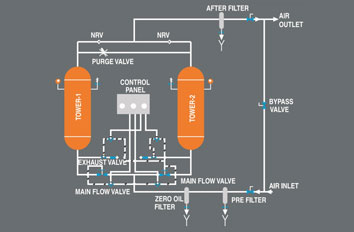Call Anytime
-
-
Send Email
sales@nitroairengineers.com
Desiccant Air Dryers

Air Dryer
A desiccant air dryer is a device used to remove moisture from compressed air. Compressed air typically contains a significant amount of water vapor, which can cause issues in various applications, such as in industrial processes, pneumatic tools, or electronics manufacturing. Excessive moisture can lead to corrosion, malfunctioning equipment, reduced efficiency, and damage to sensitive components.
A desiccant air dryer uses a drying agent, known as a desiccant, to adsorb or absorb moisture from the compressed air. The most commonly used desiccants are silica gel and activated alumina. The process typically involves two towers or chambers filled with the desiccant material.
Working of Desiccant Air Dryer:
Desiccant Air Dryer work in three phases like Adsorption Phase, Regeneration Phase and Switching Phase
Adsorption Phase: Compressed air enters one chamber of the desiccant dryer and passes through the desiccant bed. The desiccant adsorbs the moisture from the air, trapping it within its structure. The dry air continues through the chamber and leaves the dryer.
Regeneration Phase: While one chamber is adsorbing moisture, the other chamber is being regenerated. A portion of dry air from the operating chamber is diverted to flow through the saturated desiccant bed in the regenerating chamber. This dry air carries away the moisture from the desiccant, purging it out of the system.
Switching Phase: After a certain period, the chambers switch roles. The chamber that was in the adsorption phase now goes into the regeneration phase, and the chamber that was regenerating starts adsorbing moisture. This switching process ensures a continuous supply of dry air.
Desiccant air dryers can achieve extremely low dew points, making them suitable for applications where dry air is critical, such as in food processing, pharmaceuticals, painting, and instrumentation. However, they have some limitations, including higher energy consumption compared to other types of air dryers and the need for periodic replacement or regeneration of the desiccant material.
One should make sure to select the appropriate size and type of desiccant air dryer based on the required air quality, flow rate, pressure, and other specific application requirements. Consulting with an expert or manufacturer can help determine the most suitable desiccant air dryer for your needs.
